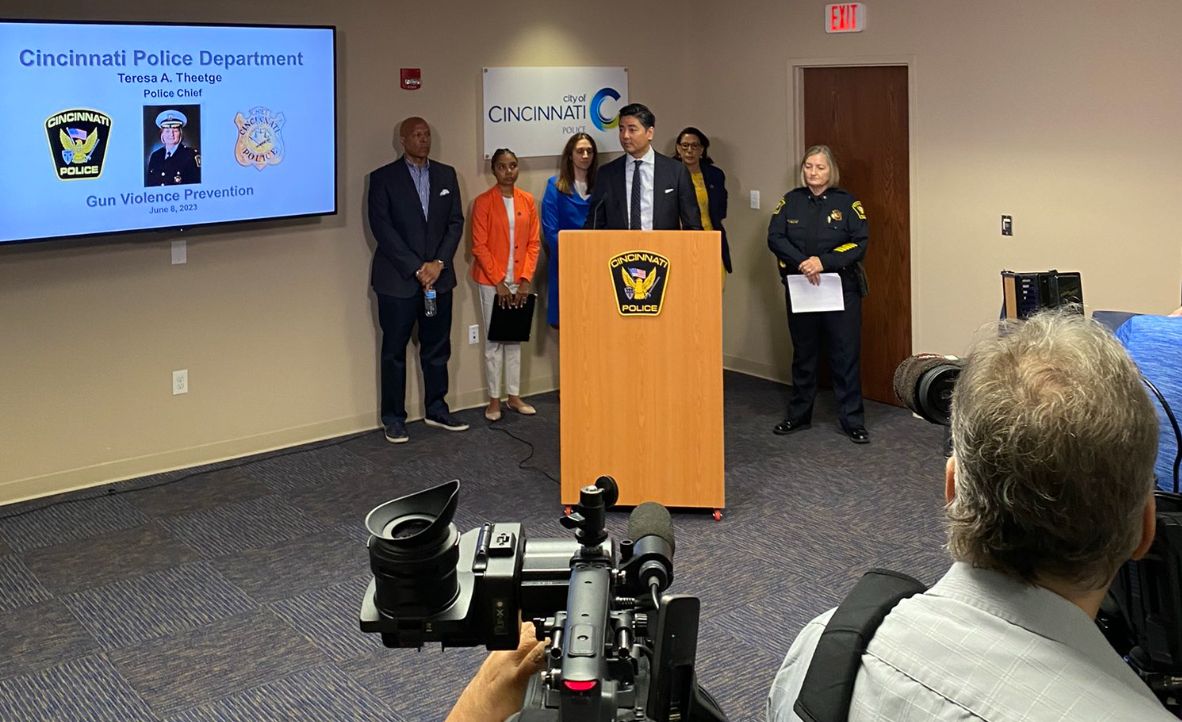CINCINNATI – City Council member Scotty Johnson didn’t mince words on Thursday when talking to a group of reporters about a recent surge in gun violence — a “crisis,” as he put it — plaguing several neighborhoods across Cincinnati.
What You Need To Know
- The city of Cincinnati plans a "holistic" approach to addressing a spike in summertime gun violence
- As of June 4, there have been 138 shootings so far in 2023, with at least 50 of those happening in the last five weeks
- CPD plans to use more overtime and street patrols this summer, but they're also partnering with community support agencies
- Chief Teresa Theetge stressed the importance of the community coming forward and talking to police
There have been at least 138 shootings involving 159 victims so far in 2023, according to the latest city data from June 4. At least 50 of those have happened in the last five weeks. One of the victims was just 7 years old, Johnson said.
“(This is a) child shot while playing; not running the streets, but playing in a courtyard,” the first-term council member said.
Johnson, who worked as a Cincinnati police officer for 33 years, said the spike in gun violence wouldn’t be solved just by policing or passing new laws.
“We’re at a point where you can’t just call Chief (Teresa) Theetge anymore. Can’t just call the mayor. You can’t just call the vice mayor or city council,” he said. “Citizens of Cincinnati, what are you going to do?”

The theme of Johnson’s two-and-a-half-minute speech echoed many of those given by Mayor Aftab Pureval, City Manager Sheryl Long, Theetge and other city officials gathered at CPD’s Criminal Investigation Sections building on Thursday morning.
A common refrain among the speakers was the need to work toward a holistic approach to addressing violence. That involves residents coming forward, both those at risk of committing crimes and those who know them. But it also requires support from a broad coalition of community leaders focused on the problem, including teachers, coaches, nonprofit groups, faith leaders, mental health professionals and others.
“Unprecedented times require unprecedented responses,” Long said, describing the city’s path forward as an “all-hands-on-deck” response.
Cincinnati has earmarked millions in its upcoming budget for programs and strategies aimed at reducing crime. Some are more traditional, such as funding three new police recruit classes, while others focus on addressing what Long described as the “roots of the problem.”
Those programs involve education, housing and job creation. The city even has a program that allows groups to apply for grant funding for blight removal and creating public art to improve the quality of life in crime-ridden areas.
Among the city’s partners in the effort are Wesley Chapel Mission Center, Cincinnati Black Theatre Co. and Seven Hills Neighborhood Houses, to name a few. Cincinnati Recreation Commission and Cincinnati Parks are also adding free programming for young people throughout the summer.
The city created a new website – Summer in Cincy – outlining a list of non-law enforcement resources it believes can address gun violence. Those range from free basketball tournaments for young people and the city’s swimming pool schedule to rent relief programs and mental health resources for adults.
The new website also has a link to information about the Cincinnati Initiative to Reduce Violence (CIRV) program. It involves the city identifying high-priority repeat offenders and working with residents and community groups to examine the root causes of chronic violence in disadvantaged neighborhoods.
The city recently released a request for proposals asking community groups to come up with ideas to specifically address violence. Officials have allocated $600,000 for the project and expect to award the grant this July.
Long described the city as having a “bottom up, not top down” approach that works “block by block” with partners who “understand the problem and the solution better than we do.”
Pureval said Cincinnati doesn’t have gang activity in the “traditional sense.” Instead, the city is seeing groups of teenagers or young adults involved in what he labeled “neighborhood beefs.”
In the past, those issues may have dissolved into fistfights or other types of violence but not shootings, the mayor added. But the mixture of gun availability and the use of social media has changed the dynamic.
As an example, he cited a recent drive-by shooting in Over-the-Rhine that resulted in a man in his 20s and three children, ages 10 to 15, going to the hospital.
Theetge stressed that Cincinnati is a safe city overall. But she said there are certain spots in specific neighborhoods where the bulk of the violent crime is occurring.
“Our officers are arresting the same people over and over again,” the chief said.
The Cincinnati Police Department is stepping up street patrols and implementing overtime, particularly in the communities that have witnessed heightened violence, Theetge said. But she stressed how crucial it is for residents to come forward to talk to officers – the old “if you see something, say something” model.
“I would venture to guess that when they shoot out of a vehicle, that’s not the first time they had a firearm in their hand and somebody probably saw them in the days prior, weeks prior with a firearm in their possession,” she added. “If somebody would call us so we can intervene sooner, maybe we could prevent that drive-by shooting.”
Anna Albi of the Moms Demand Action organization was grateful to city leaders for coming together to outline what she called a “holistic approach to gun violence reduction.”
Albi, a City Council candidate, said community safety means ensuring everyone has access to fresh food, housing, livable wages, well-resourced schools and youth programs, health care and mental health resources.
“There is no magic wand solution to gun violence,” she said. “It takes all of us working together to foster safe communities.”



